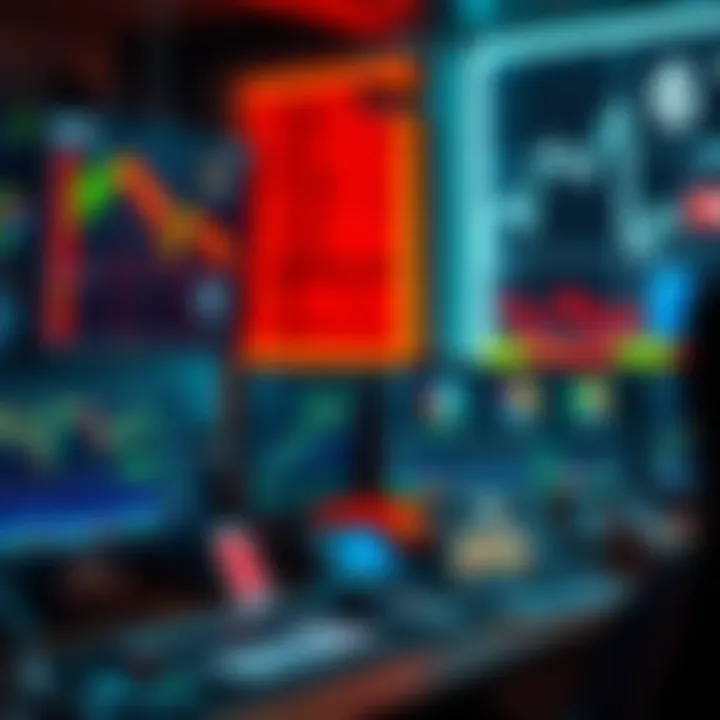Characteristics of Top Futures Trading Rooms


Intro
In the world of investing, particularly in futures trading, understanding the environment where trades are executed is vital. Trading rooms can make or break an investor's performance. Whether you’re a beginner or seasoned trader, a well-equipped trading room can provide the resources, mentorship, and community support necessary to thrive. Exploring the nuts and bolts of these trading rooms gives a comprehensive view of what to look for when making decisions about where to trade.
These trading rooms are often described through specific features—educational resources, tools, or community support—that not only enhance the skill set of traders but also help them navigate the complexities of the financial markets. A nuanced look at these elements will reveal their importance in maximizing profit potential and minimizing risk.
Let's delve deeper into the characteristics and components that exemplify the best futures trading rooms, and, in the process, understand how to select one that aligns with individual trading goals.
Investment Terminology
Understanding the language of trading is crucial. Here are some common terms that run rampant in the futures trading landscape:
Definitions of Common Terms
- Futures Contract: An agreement to buy or sell an asset at a predetermined price at a specified time in the future.
- Leverage: Using borrowed capital to increase the potential return on investment. It can amplify gains but also increases exposure to risk.
- Margin: The amount of capital that a trader must deposit with a broker to open a position in the market. It can be seen as a good faith deposit.
- Pips: A term often used to describe the smallest price move that a given exchange rate can make based on market convention. In futures, while not always referred to as pips, the concept remains important for measuring movement.
Industry Acronyms and Abbreviations
Acronyms can frequently be a source of confusion, particularly for newcomers:
- FOMC: Federal Open Market Committee—responsible for overseeing monetary policy.
- CME: Chicago Mercantile Exchange, a marketplace for futures trading.
- CFD: Contract for Difference, an agreement to exchange the difference in value of a trading instrument between the time the contract is opened and closed.
These terms and acronyms form the building blocks of communication within futures trading rooms. Gaining familiarity with them helps demystify discussions and facilitates smoother interactions in trading environments.
Expert Insights and Advice
To further refine trading strategies, absorbing the advice of experts can be instrumental. Let’s look at some key areas:
Strategic Investment Approaches
Expert traders often employ various strategies to navigate market fluctuations. Some notable ones include:
- Trend Following: Investing in the direction of the prevailing market trend, whether it be bullish or bearish.
- Hedging: Purchasing a futures contract to offset or mitigate potential losses in a related asset.
- Scalping: A quick trading strategy that profits from minor price changes, often requiring high precision and speed.
Risk Management Techniques
Risk management stands at the forefront of any successful trading strategy. Here are key techniques:
- Diversification: Spreading investments across multiple assets to reduce risk.
- Stop-Loss Orders: Automated orders to sell a security when it reaches a certain price, limiting potential losses.
- Position Sizing: Determining the amount of capital to allocate to a single trade based on risk tolerance and account size.
Understanding these investment approaches and risk management methods can elevate a trader's capabilities. It enables individuals to craft strategies and tackle challenges within the volatile realm of futures trading.
"A wise trader does not merely follow the urging of their gut but leans on informed strategies and comprehensive knowledge."
Engaging with a futures trading room that embodies these characteristics can be transformative. The blend of robust educational resources, seasoned mentorship, and active community engagement can propel one's trading journey to new heights.
For further exploration on futures trading and investment strategies, consider checking out resources like Investopedia, and CME Group. Furthermore, engaging with communities on platforms such as Reddit can also yield valuable insights.
Prelims to Futures Trading
The world of futures trading opens a unique landscape for investors seeking to diversify their portfolios and optimize their trading strategies. It is a way to profit from the anticipated movement of an asset's price without having to own the underlying asset outright. Whether one is a newcomer to the trading scene or a seasoned player, understanding the essentials of futures trading is crucial.
When investors decide to step into the realm of futures, they are often met with a mix of excitement and trepidation. The significance of futures contracts cannot be understated, as they provide insights into market trends and allow for speculative opportunities. A futures contract is essentially an agreement to buy or sell an asset at a predetermined price on a future date. This can vary from commodities like corn or oil to financial instruments such as stock indices. For beginners, the beauty of these contracts lies in the leverage they provide. A small investment could lead to sizable gains—or losses—thus making market knowledge and decision-making absolutely essential.
Additionally, the efficacy of trading rooms plays a pivotal role in shaping the futures trading experience. These environments serve as hubs for learning, collaboration, and strategy refinement. They offer resources that help traders make informed decisions, allowing them to refine their approaches and engage with fellow traders. As we delve deeper into the subject, it becomes clear that trading rooms are more than mere venues; they are communities that enhance one’s trading journey. By fostering a supportive and resource-rich environment, they make complex trading concepts more accessible, thus bridging the gap often felt by lone traders.
In this article, we will uncover the defining characteristics of effective futures trading rooms, their educational offerings, and how they can align with various trading strategies. Ultimately, the right trading room can be a game changer, impacting not just the knowledge but the performance of traders in the fast-paced world of futures.
"Education is the most powerful weapon which you can use to change the world." - Nelson Mandela
With that in mind, let us further explore the intricacies of futures contracts, ensuring we lay a solid foundation for navigating the dynamic realm of trading.
Defining the Best Futures Trading Rooms
When diving into the expansive universe of futures trading, identifying the traits that separate the wheat from the chaff in trading rooms becomes essential. A properly defined futures trading room isn't just a space filled with screens and monitors; it's a vibrant hub that fosters growth, learning, and success. The significance of this topic is rooted in the fact that choosing the right trading room can greatly influence an investor's skillset and profitability.
Understanding the nuances that denote a high-quality trading room can save traders from pitfalls. It’s not just about profit margins; it's about developing a comprehensive understanding of markets and trading strategies. Each trading room possesses its unique fingerprint, but they should generally embody certain key characteristics, all of which can enhance an investor’s journey.
Key Attributes of a High-Quality Trading Room
No two futures trading rooms are created equal. Thus, identifying some of the hallmark features of exemplary rooms is vital.


- Comprehensive Educational Resources: A top-notch trading room will offer a treasure trove of educational materials. This should encompass everything from beginner tutorials to advanced trading strategies. Interactive webinars, written guides, and video tutorials can help traders sharpen their skills at their own pace.
- Real-Time Market Analysis: The best trading environments allow for constant updates about market movements. Access to live data feeds and professional analysts’ inputs can provide significant advantages, helping traders make more informed decisions quickly.
- Strong Community Support: The value of camaraderie should not be overlooked. Stronger trading rooms foster a sense of community, enabling traders to exchange ideas, insights, and strategies with their peers. This can be a huge confidence booster for novices.
- Access to Professional Mentorship: Novice traders particularly benefit from guidance by seasoned pros. The presence of mentors who are willing to share their knowledge and experiences is an invaluable attribute of high-quality rooms.
- User-Friendly Trading Platforms: Ease of use is crucial. If the trading platform is cumbersome or hard to navigate, it can detract from a trader's overall experience and their capacity to focus on strategic decisions.
In every corner of a trading room, these attributes spark an environment ripe for growth.
Evaluating Performance Metrics
One cannot judge a trading room solely on its appearance or advertised features. Digging deeper into performance metrics can provide much clearer insights into a trading room's effectiveness.
Key performance metrics to keep an eye on include:
- Win Rate: Knowing how often the average trader in the room reports a profitable trade gives insight into the efficacy of the trading strategies taught.
- Risk-Reward Ratio: A higher risk-reward ratio generally signifies a less aggressive trading approach, which can help in sustaining long-term investment success.
- Average Return on Investment (ROI): Tracking how much members are earning compared to what they invest can inform potential members about expected outcomes.
- Member Retention Rates: High retention often signals satisfaction and successful mentorship.
These metrics act like radar in the stock market sky, providing clarity in a realm that can often feel overwhelming.
Ultimately, understanding what defines the best futures trading rooms empowers traders to make informed decisions and strategically navigate their journeys in this complex landscape. For a deeper dive into the topic, resources like Investopedia and CME Group serve as excellent starting points.
Educational Offerings in Trading Rooms
In the world of futures trading, the knowledge you possess can be a game changer. Depending on your base of understanding, outcomes can drastically differ. Educational offerings in trading rooms hold immense importance for traders, whether novice or seasoned. A comprehensive educational framework often encompasses webinars, online courses, and other resources tailored for enhancing trading skills. This structured learning path can provide it’s users not just theoretical knowledge but also practical insights into the market's nuances.
Investment isn't solely about capital; it's fundamentally about informed decisions. When trading rooms provide educational resources, they aren't just promoting learning but fostering an ecosystem where traders can grow astutely and gain confidence in their strategies. The benefits of such offerings go beyond individual learning; they create a community of informed traders who can support one another through information sharing and dialogue.
Moreover, with markets evolving rapidly, continuous learning helps in keeping pace with new strategies and tools. The old saying, "If you aren't learning, you aren't growing," rings particularly true here.
Webinars and Online Courses
Webinars and online courses serve as cornerstone assets in the educational landscape of trading rooms. Many trading rooms leverage technology to deliver real-time insights into market trends and strategies that can easily be accessed from the comfort of your own home. These sessions often feature experienced traders who share their expertise, providing unique perspectives that can be rare in textbooks.
The practical nature of webinars means that participants often get to ask questions and interact with instructors directly. This engagement transforms passive learning into an active dialogue. Traders can explore complex topics in a simplified manner, making it easier to grasp seemingly intricate concepts.
On the other hand, online courses often serve as a more structured learning pathway. Participants can study at their own pace, which can be a real blessing for those balancing other commitments. Here are some noteworthy aspects of webinars and online courses:
- Flexible Learning: Most online resources allow you to learn whenever it fits into your schedule, avoiding the hassle of traditional classroom setups.
- Diverse Topics: From introductory sessions to complex strategies involving options and spread trading, these resources offer a plethora of knowledge tailored to different skill levels.
- Access to Industry Experts: Many webinars are conducted by traders who have had their share of wins and losses, providing real-world context that is often missing from other educational mediums.
- Interactive Environment: The chance to engage in Q&A sessions makes the learning experience richer and more tailored to individual queries.
Trading Simulations
Trading simulations are another crucial educational tool offered by many trading rooms. A real-world trading environment, often replicated through simulations, lets traders practice without the risk of real capital loss. These simulated platforms usually include real-time market data, allowing users to experience market movements as they happen.
The simulation experience provides an invaluable chance to test strategies in a risk-free setting. Traders often encounter scenarios that could unfold in actual market conditions, which can help in honing their decision-making skills under pressure.
Key aspects of trading simulations include:
- Real-Time Trading Experience: Gaining hands-on experience in trading without the financial implications, helps in building confidence.
- Immediate Feedback: Users can see the results of their decisions instantly, which is vital for understanding market reactions.
- Strategy Testing: Traders can experiment with various strategies, evaluate their effectiveness, and adapt accordingly before committing actual funds.
- Community Engagement: Often, participants can share insights and outcomes with fellow traders, fostering a collaborative learning environment.
Such dedication to learning can be the thin line separating failure and success in the ever-volatile world of futures trading.
Mentorship and Guidance
Mentorship and guidance form the backbone of success for many traders navigating the complex world of futures trading. In an arena marked by rapid fluctuations and uncharted waters, having access to seasoned veterans who can share their insights becomes not just beneficial, but essential. Beyond merely offering advice, mentorship can help shape one's trading style, bolster confidence, and refine strategic thinking. Let's explore the specific elements and benefits of mentorship in trading rooms, as well as important considerations to keep in mind.
Role of Experienced Traders
Experienced traders serve as invaluable resources in trading rooms, often acting as both teachers and role models. Their real-world experience cannot be replicated by textbooks or online courses. Here are some key roles they fulfill:
- Knowledge Sharing: They provide firsthand insights into market behaviors, which isn't often found in standard educational content. This can include understanding psychological triggers behind market moves or identifying patterns.
- Real-Time Feedback: Having someone who can evaluate your trades and strategies in real-time can help avoid costly mistakes. It's like having a seasoned navigator onboard during a stormy voyage.
- Networking Opportunities: Experienced traders often bring along a network of contacts, enhancing your opportunities for collaboration, partnerships, and learning from diverse perspectives.
In lighting the way for newer traders, seasoned professionals not only elevate their trading strategies but infuse them with the necessary courage to venture into new market territories.
Structured Mentorship Programs
Structured mentorship programs within trading rooms provide a systematic approach to learning and development. These programs often have curated content aimed at addressing both the hard and soft skills necessary for successful trading.
Here are features that typically characterize effective mentorship programs:
- Goal-Oriented Curriculum: Mentorship programs are often designed with clear objectives in mind, catering to traders at different skill levels. This ensures that lessons learnt are aligned with individual development needs.
- Regular Check-Ins and Assessments: Having a schedule for regular meetings can foster accountability. It allows for the continual assessment of progress and adjustments to learning paths as needed.
- Hands-On Experience: Many programs incorporate a practical element, simulating real market scenarios to build experience without financial risk.
"A mentor is someone who allows you to see the hope inside yourself." – Oprah Winfrey
When choosing a trading room, look for those that boast solid mentorship programs. Not only can this provide a support system but also launch your path toward mastery in futures trading. Ultimately, the synergy between mentorship and guidance in trading rooms cultivates a space for nuanced learning, which can make all the difference in an investor's journey.
Technology and Trading Tools


In the fast-paced universe of futures trading, having the right technology and tools can mean the difference between steady gains and missed opportunities. Advanced software and platforms streamline processes, offer in-depth analytics, and bolster traders' capabilities. Understanding how these tools work is not just advisable; it's essential for both beginners and seasoned investors looking to sharpen their competitive edge.
Analysis Software and Platforms
When diving into futures trading, analysis software acts like a compass for traders navigating through the intricate markets. These platforms are designed to provide traders with real-time insights, predictive analytics, and robust charting capabilities.
Some popular platforms, like NinjaTrader and Thinkorswim, allow users to customize their trading environment. Features worth noting include:
- Customizability: Users can set up their workspaces according to personal preferences, which streamlines the trading process.
- Charting Tools: These platforms often come equipped with advanced technical indicators, helping traders spot trends and make informed decisions on entry and exit points.
- Backtest Capabilities: Some software permits users to test trading strategies using historical data, enabling them to see how their approaches hold up under various market conditions.
Having access to such analysis software not only aids in understanding market behaviors but can also enhance decision-making precision—something that can be pivotal during periods of volatility.
Data Accessibility and Real-Time Updates
In futures trading, timing is everything. This brings us to the vital aspect of data accessibility and real-time updates. Effective trading rooms leverage technology to ensure that traders get crucial information as it happens. This immediacy can lower the risk of losses due to lagging information. Here's what to consider:
- Real-Time Market Feeds: Having access to live data feeds can be a game-changer. It allows traders to react instantaneously to market shifts, ensuring they are always a step ahead.
- News Integration: Platforms that integrate news alerts or economic calendars provide traders with context behind price movements. Understanding economic indicators, such as GDP releases or employment data, can aid in refining trading strategies.
- Mobile Access: Mobile apps allow traders to monitor positions and execute trades on-the-go. This flexibility can be crucial when unexpected market events occur.
Community and Network Support
Community and network support are pivotal components of a successful futures trading room. The trading process can often feel isolated, with traders staring at screens, trying to decipher market movements and make educated decisions. However, a robust community aspect can transform this solitary endeavor into a more collaborative and enriching experience.
Having a circle of like-minded individuals provides essential emotional and intellectual support. It fosters an environment where traders are encouraged to share strategies, insights, and lessons learned from their own trading journeys. This sharing of knowledge not only accelerates learning but also helps in reducing the mistakes that beginners might typically make.
Forums and Discussion Groups
Forums and discussion groups serve as the backbone of community support within many trading rooms. These platforms allow traders to engage in real-time discussions about market conditions, strategies, or specific trading instruments. Being a part of such forums provides numerous benefits:
- Diverse Perspectives: Engaging with a mix of seasoned and novice traders can open one’s mind to new trading strategies that might not be evident to solitary traders.
- Quick Problem Solving: When a trader faces a challenge or has a question, they can quickly seek advice from others who might have already encountered similar issues.
- Accountability: Many traders find that being part of a community helps them stay accountable to their trading plans and goals.
Researching or participating in groups found on platforms like Reddit (e.g., r/FuturesTrading) or Facebook can sometimes be enlightening for both beginners and seasoned investors. These interactions lay the groundwork for deeper connections and ongoing conversations.
"Success in trading is not just about individual insight but also learning from a community's achieved knowledge."
Building a Supportive Network
Building a supportive network goes beyond mere interaction on forums. It involves forming genuine connections with fellow traders and mentors who can offer guidance and share experiences. Here’s how to effectively build such a network:
- Attend Trading Workshops: Many trading rooms host workshops and webinars. Attending these is a great way to meet other participants with similar interests.
- Participate Actively: Don’t just be a lurker in forums; contribute your thoughts, insights, and questions. Engagement often leads to deeper connections.
- Utilize Social Media: Platforms like LinkedIn and trading-specific sites can help you connect with experienced traders and industry professionals.
- Seek Out Mentorship Opportunities: Many seasoned traders are willing to take on mentees; being proactive can lead to invaluable guidance.
- Stay Open to Collaboration: Sometimes, joint ventures or partnerships can yield great outcomes. Finding a fellow trader to collaborate on market research or trades might yield insights that could have gone unnoticed when working alone.
In sum, having a community and a solid support network at your disposal significantly enhances the trading experience. It transforms what can often be a daunting task into a more manageable, even enjoyable, pursuit. With collaboration at its heart, traders can learn, adapt, and thrive in the complex world of futures trading.
Cost and Membership Options
Selecting the right futures trading room involves a careful examination of the cost structures and membership options available. This aspect is vital not only because it impacts one’s budget but also because it can significantly influence the overall trading experience. Ultimately, understanding the dynamics of costs can ensure that investors get the most value for their money, thereby maximizing their potential for success.
Membership Fees and Value Assessment
Membership fees can vary widely among trading rooms, and assessing their value demands a thorough analysis. Some platforms charge a flat monthly fee, while others may employ a commission-based structure depending on the trading volume or type of trades executed. It’s essential to consider what you receive in return for these fees. An expensive membership might seem daunting, yet if it offers robust educational resources, advanced trading tools, or exceptional guidance, it could be worth the investment.
Investors should ask themselves:
- What educational content is available, like courses or mentorship?
- Is there sufficient technical support?
- Do members enjoy access to exclusive trading tools or software?
Evaluating these elements can help in determining if a trading room’s cost aligns with personal trading goals. Some trading rooms might also offer tiered membership levels, which can provide different services according to price. This gradation allows traders to select an option that fits their financial situation and trading aspirations better.
Trial Periods and Refund Policies
Trial periods can be an invaluable tool for determining if a specific trading room suits your needs. Many trading rooms offer free or low-cost trial memberships, allowing potential members to explore the functionalities and resources available without heavy financial commitment. During this time, users can assess not just the educational offerings, but also the responsiveness of support teams and the overall trading atmosphere.
A transparent refund policy is equally important; it provides peace of mind when committing to a membership. Traders should look for trading rooms that offer satisfaction guarantees or money-back promises. This feature signals confidence in their services and often assists newcomers in making informed decisions.
In deciding where to invest, remember:
- Determine the trial length—usually ranging from a week to a month.
- Be well-acquainted with the refund procedure, including timelines and requirements.
- Pay attention to user feedback regarding cancellation experiences, as they can shed light on the operational integrity of the trading room.
"The most prudent investors never forget—the best trade is one that aligns clearly with their financial goals and trading strategy."
A well-thought-out approach to cost and membership options will pave the way for a more fruitful trading journey. Prospective members should take the time to analyze various offerings and ensure they are entering a community that complements their style and ambitions in the futures market.
User Reviews and Testimonials


User reviews and testimonials play a pivotal role in understanding the quality of futures trading rooms. They provide a window into the experiences of actual users, offering insights on various aspects such as support services, trading resources, and overall member satisfaction. In a landscape where choices abound, these reviews can be the compass that guides new and seasoned traders alike toward an informed decision.
The bustling world of futures trading is often seen as a high-stakes game. Therefore, hearing from real users helps demystify the intricacies of the trading rooms in question. Feedback can vary from praise to criticism, offering a balanced view that potential members can evaluate before committing. It’s essential to sift through the noise of online reviews to find the gems of genuine insight.
One substantial benefit of user reviews is their ability to highlight recurring themes. For example, if many reviews mention the quality of mentorship, this points to a strength of that trading room. Conversely, frequent complaints regarding customer service could indicate a red flag.
It is equally important to consider the context of these reviews. A positive experience may not translate to success for everyone due to personal trading strategies or risk tolerance. Therefore, prospective members should endeavor to read multiple reviews, weighing both the pros and cons.
"In the land of trading, my experiences were like a map where reviews were the signposts guiding me to make wise choices."
In summary, user reviews and testimonials are more than just anecdotal evidence—they serve as a valuable resource for anyone considering joining a futures trading room. They provide a realistic glimpse into the functionalities and offerings of each room, helping to bridge the gap between expectation and reality.
Analyzing Feedback from Members
When scrutinizing user feedback, a few key areas should be examined closely. The quality of education provided, the effectiveness of customer support, and community engagement are three noteworthy aspects that often surface in reviews. Each of these points not only reflects the room's overall competency but also affects members' trading capabilities and satisfaction.
- Educational Quality: Members often rate the quality of webinars and courses offered. Reviews that highlight engaging content and knowledgeable trainers often indicate good educational practices.
- Customer Support: Feedback on how quickly and effectively members receive help can be enlightening. A common complaint in reviews might be that response times are slow or that representatives lack knowledge about the trading tools offered.
- Community Engagement: The strength of the community affects member retention. Users who report active forums or helpful support from fellow traders often mention feeling more connected and supported.
In evaluating this feedback, potential members should take a holistic view. Reading between the lines of each review can reveal the nuances of each trading room. The same goes for testimonials highlighting successful trades—they often bring a personal touch and detail the process that led to those successes.
Success Stories and Outcomes
Success stories in trading rooms are particularly influential. These testimonials often provide evidence of what works, allowing potential members to grasp what the right fit might entail for them. Detailed accounts of members achieving their financial goals through a specific trading room can bolster a newcomer’s confidence in their choice.
Several elements typically emerge from these success stories:
- Personal Journey: Many traders start as novices and recount the step-by-step growth they experienced. This often includes how they overcame hurdles and adapted their strategies thanks to the guidance received.
- Before and After Scenarios: Successful testimonials sometimes feature a
Comparison Among Leading Trading Rooms
In the vast realm of futures trading, selecting the right trading room can feel akin to finding a needle in a haystack. Each trading room boasts its unique characteristics and features, making it essential to perform a thorough comparison. This section serves not only as a guide but also as a reference point for traders aiming to enhance their trading experiences.
The importance of comparing leading trading rooms cannot be overstated. A trader’s success hinges on several factors, including the education provided, the tools available, and the community that surrounds them. Engaging directly with multiple trading rooms allows potential members to appreciate the nuanced differences each one offers. This comparison helps in identifying which room aligns best with one's trading style and objectives.
Feature-Wise Analysis
When it comes to features, each trading room offers various tools and resources. Here are some key elements to consider:
- Trading Platforms: Different trading rooms have different platforms and interfaces. Some might have advanced charting tools, while others might focus on simplicity. It’s vital to choose a room that offers a platform you find comfortable and intuitive.
- Market Analysis: The depth of market analysis is another critical area. Look at how frequently updates are provided. For instance, some rooms might offer daily analysis, while others provide deeper monthly insights.
- Educational Resources: It is crucial to assess the quality of educational materials such as webinars, articles, and tutorials. High-quality content can significantly impact your learning curve.
- Customer Support: Evaluate how responsive the customer support is. Quick and effective support can change your experience entirely, especially when urgent issues arise.
By dissecting these features, a trader can more effectively gauge which trading room suits their needs. Just as no two traders are alike, no two trading rooms offer identical experiences.
Cost-Benefit Evaluation
Once you grasp the features available, the next logical step is to measure them against the costs involved. Pricing structures can vary considerably among trading rooms. Here are some considerations:
- Membership Fees: Look for transparency in membership fees. Some rooms may require a hefty one-time payment, while others might have monthly subscriptions. Understanding how these fees correspond with the offered benefits is key.
- Additional Costs: Be aware of any hidden charges. Costs may arise for premium features or exclusive seminars.
- Return on Investment (ROI): This is an essential metric. Weigh the benefits of tools, resources, and mentorship against what is paid. If the value exceeds the costs, you’re likely on the right path.
Ultimately, a cost-benefit evaluation goes beyond simple mathematics. It requires a consideration of how these costs align with your trading goals, experience level, and overall financial strategy. Traders should feel empowered to ask themselves: Does the value outweigh the monetary commitment?
"The art of trading is not just about making money; it's about creating a systematic approach that aligns with your unique goals."
This focused analysis of leading trading rooms not only instills confidence but also empowers both new and seasoned traders to make informed choices. As the futures market evolves, the right trading environment can be the distinction between success and stagnation.
Epilogue and Future Outlook
As we wrap up our examination of the best futures trading rooms, it's essential to reflect on the strategies to navigate this complex but rewarding landscape. Choosing a trading room isn’t just about finding a space to make trades; it encapsulates the environment where one can transform knowledge into tangible results. For traders, whether beginners or seasoned, the right trading room serves as a crucial pillar for their investment journey.
Several key elements stand out prominently when considering a futures trading room:
- Educational Resources: A quality trading room should prioritize education. You’d want access to webinars, seminars, and continuous learning avenues. This supports traders in adapting to market changes and enhances their skills over time.
- Mentorship Opportunities: Experienced traders can offer guidance that could prove invaluable. Programs that place newcomers with seasoned pros can create lasting relationships that foster learning and growth. Such partnerships are often what differentiate successful traders from the rest.
- Technology and Tools: The trading environment changes rapidly. The best trading rooms utilize cutting-edge technology to keep their members equipped with the latest tools, ensuring they're never left behind.
In considering these features, pay particular attention to how a trading room aligns with your personal investment strategies and goals. A room may boast a strong community and top-notch tools, but if its focus does not resonate with your own strategies, it may not yield the results you expect.
"Choosing the right trading room is much like choosing a mentor; fit is crucial to your long-term success."
Final Thoughts on Selecting a Trading Room
Ultimately, the selection of a trading room boils down to individual requirements and preferences. Evaluate what matters most to you—access to market analysis, the vibrancy of the community, or comprehensive educational offerings. A well-matched trading environment can propel you toward your financial aspirations. Don't shy away from asking questions before committing; a trial period or informal discussions can provide insight into whether the room suits your trading style.
Emerging Trends in Futures Trading
As the financial landscape evolves, it's all about staying ahead of the curve. One trend gaining traction is the increased reliance on artificial intelligence and algorithms in trading strategies. More firms are leveraging AI to predict market movements and automate decision-making processes, bridging the gap between human intuition and machine efficiency.
Moreover, the rise of decentralized finance (DeFi) has started to impact traditional futures trading. Traders should keep an eye on how blockchain technology could reshape the industry by enhancing transparency and security in trading operations.
Keeping these trends in mind, it's prudent to foster adaptability in your trading practices. Embrace technology, stay curious about new methodologies, and remain open-minded regarding the incorporation of emerging trends. The future of futures trading holds both challenges and opportunities, and preparation is key to navigating veritable waters ahead.







